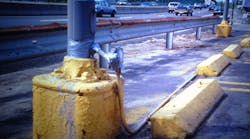Bearing-related problems are among the most common causes of motor failures. Solving those problems will reduce motor failures.
Did you know bearing-related problems cause more than half of all motor failures? Because of this, you must pay special attention to bearings, bearing housings, and shafts when carrying out inspections of and maintenance procedures for motors.
When a motor fails, you should check its bearings - even if the motor windings are blackened and still smoking! Yes, it's possible the motor malfunction was due to a voltage problem, or an excessively hot, moist, or otherwise bad environment. But most of the time, a bearing-related problem is the root cause. For example, a bearing that is beginning to gall can place an extra load on the motor. That extra load would then, in turn, cause the motor to draw excessive current.
How do you determine the root cause of a motor failure? First, you should carefully inspect bearings and housings for dirt or contamination, damage, dents, scratches, out-of-round balls or races, or distortion of any kind. Next, check the shaft and end "bells" for wear or damage. If the shaft is worn or damaged in any way, arrange for repairs. Many motor repair shops can apply new metal to the shaft by flame-spray metallizing and turn it down to its original specifications - resulting in a shaft that's as good as new.
After you complete all motor repairs, be sure the service firm checks all components for proper size and fit, per a manufacturer's specification sheet or other authoritative documentation. Tolerances must permit all components to expand during operation of the motor and yet maintain proper "freewheeling" with no binding that could cause overheating and eventual failure.
When the motor is reassembled, check it for freedom of rotation. You should also perform tests when you place it back in operation. This includes voltage and current checks, insulation resistance tests, and a complete vibration analysis check and alignment tests. Another important step many people forget is to check that sleeve bearings are properly insulated from housing metal. If you omit this protection, circulating currents could cause pits or other damage on the shaft, bearings, and housing.
Watch out for bearing endplay. The proper amount of endplay is critical because as the shaft expands during operation of the motor, enough room must be available to avoid binding of any sort that would shorten bearing life.
All motors will have some amount of endplay in the range of 1/32 in. to 1/16 in. However, some designs have a locked bearing at one end, which results in the rotor not moving in an axial direction. Therefore, the opposing bearing must be able to move or "float" to provide the required freedom. Only people trained in dealing with arrangements of this type should check these.
Primary causes of excessive, damaging endplay include worn bearings or bearing housings, a worn or bent shaft, or contamination that could cause binding, wear, and excessive endplay - in that order. Usually, excessive endplay is hard to detect during normal operation and inspection unless it is extreme. Excess vibration is one symptom that might alert you. So is excess heat at the shaft. If you have either of these problems, suspect endplay, and have a motor-repair expert perform further diagnostics.


